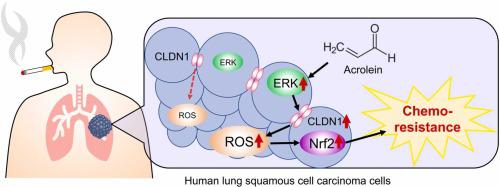Toxicology Letters ( IF 2.9 ) Pub Date : 2023-12-22 , DOI: 10.1016/j.toxlet.2023.12.012 Hiroaki Eguchi 1 , Yaqing Yu 1 , Toshiyuki Matsunaga 2 , Yuta Yoshino 1 , Akira Ikari 1

|
Tobacco smoke contains various carcinogenic ingredients such as nicotine, acrolein, and benzopyrene; however, their effects on cancer treatment are not fully understood. Claudin-1 (CLDN1), a component of tight junctions, is involved in the increased resistance to anticancer drugs. In this study, we found that acrolein increases the mRNA and protein levels of CLDN1 in RERF-LC-AI cells derived from human lung squamous cell carcinoma (SCC). Acrolein increased the p-extracellular signal-regulated kinase (ERK) 1/2 levels without affecting the p-Akt level. The acrolein-induced elevation of CLDN1 expression was attenuated by U0126, a mitogen-activated protein kinase kinas (MEK) inhibitor. These results indicate that the activation of MEK/ERK pathway is involved in the acrolein-induced elevation of CLDN1 expression. In a spheroid model, acrolein suppressed the accumulation and toxicity of doxorubicin (DXR), which were rescued by CLDN1 silencing. The acrolein-induced effects were also observed in lung SCC-derived EBC-1 and LK-2 cells. Acrolein also increased the expression level of nuclear factor erythroid 2-related factor 2 (Nrf2), a transcription factor that regulates antioxidant and detoxifying genes, which were inhibited by CLDN1 silencing. In spheroid cells, the levels of reactive oxygen species were enhanced by acrolein, which was inhibited by CLDN1 silencing. Taken together, acrolein may reduce the anticancer drug-induced toxicity in human lung SCC cells mediated by high CLDN1 expression followed by the upregulation of Nrf2 signaling pathway.
中文翻译:

丙烯醛通过激活人肺鳞状细胞癌细胞球体模型中的claudin-1和Nrf2轴来抑制抗癌药物诱导的毒性
烟草烟雾中含有尼古丁、丙烯醛、苯并芘等多种致癌成分;然而,它们对癌症治疗的影响尚未完全了解。 Claudin-1 (CLDN1) 是紧密连接的一个组成部分,与抗癌药物耐药性的增加有关。在这项研究中,我们发现丙烯醛增加了源自人肺鳞状细胞癌(SCC)的 RERF-LC-AI 细胞中 CLDN1 的 mRNA 和蛋白质水平。丙烯醛增加 p-细胞外信号调节激酶 (ERK) 1/2 水平,但不影响 p-Akt 水平。 U0126(一种丝裂原激活蛋白激酶激酶 (MEK) 抑制剂)可减弱丙烯醛诱导的 CLDN1 表达升高。这些结果表明MEK/ERK途径的激活参与丙烯醛诱导的CLDN1表达升高。在球体模型中,丙烯醛抑制了阿霉素 (DXR) 的积累和毒性,而 CLDN1 沉默可以挽救这种情况。在肺 SCC 衍生的 EBC-1 和 LK-2 细胞中也观察到了丙烯醛诱导的作用。丙烯醛还增加了核因子红细胞 2 相关因子 2 (Nrf2) 的表达水平,Nrf2 是一种调节抗氧化和解毒基因的转录因子,这些基因受到 CLDN1 沉默的抑制。在球状细胞中,丙烯醛提高了活性氧的水平,而丙烯醛则被 CLDN1 沉默所抑制。总而言之,丙烯醛可以降低抗癌药物诱导的人肺鳞状细胞癌细胞毒性,该毒性是由高 CLDN1 表达和 Nrf2 信号通路上调介导的。


















































 京公网安备 11010802027423号
京公网安备 11010802027423号